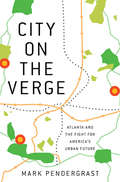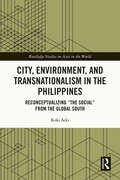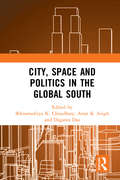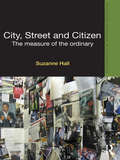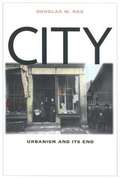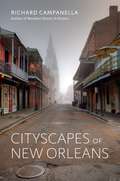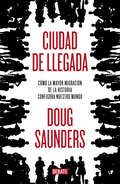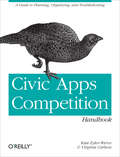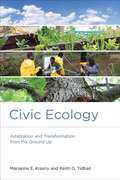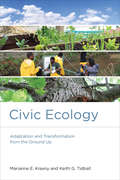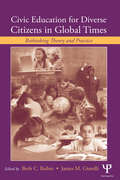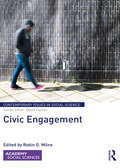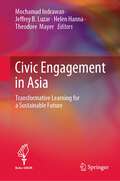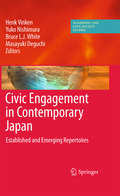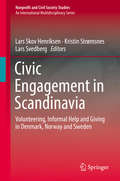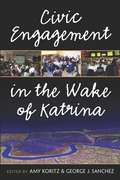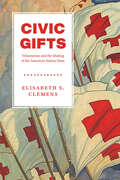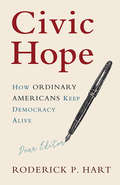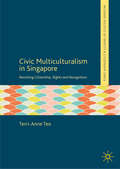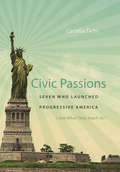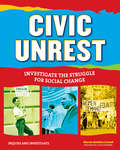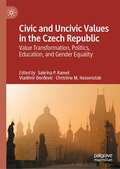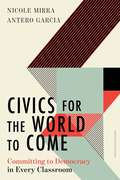- Table View
- List View
City on the Verge: Atlanta and the Fight for America's Urban Future
by Mark PendergrastAtlanta is on the verge of tremendous rebirth-or inexorable decline. A kind of Petri dish for cities struggling to reinvent themselves, Atlanta has the highest income inequality in the country, gridlocked highways, suburban sprawl, and a history of racial injustice. Yet it is also an energetic, brash young city that prides itself on pragmatic solutions.Today, the most promising catalyst for the city's rebirth is the BeltLine, which the New York Times described as "a staggeringly ambitious engine of urban revitalization." A long-term project that is cutting through forty-five neighborhoods ranging from affluent to impoverished, the BeltLine will complete a twenty-two-mile loop encircling downtown, transforming a massive ring of mostly defunct railways into a series of stunning parks connected by trails and streetcars. Acclaimed author Mark Pendergrast presents a deeply researched, multi-faceted, up-to-the-minute history of the biggest city in America's Southeast, using the BeltLine saga to explore issues of race, education, public health, transportation, business, philanthropy, urban planning, religion, politics, and community. An inspiring narrative of ordinary Americans taking charge of their local communities, City of the Verge provides a model for how cities across the country can reinvent themselves.
City, Environment, and Transnationalism in the Philippines: Reconceptualizing “the Social” from the Global South (Routledge Studies on Asia in the World)
by Koki SekiSeki presents an ethnography of uncertainty and precarity experienced by people in urban, rural, and transnational, communities in the Philippines as a case study of social protection without the possibility of a robust welfare state. He deals with topics including urban poverty, environmental degradation, and transnational migration. Throughout these chapters, Seki elaborates on the modes of security and protection that people living at the margins of global capitalism create through mobilizing their sociality and networks. He traces the emerging configuration of "the social," a collectivity and connectedness that ensures a sense of security in life among people. The social can be defined as an idea or institution, which had enabled formal and impersonal solidarity such as that which provided the underpinnings of the modern welfare states of the West during the mid-20th century. In the twenty-first century the social in this context is experiencing a fundamental reconfiguration as it faces deepening insecurity, risk, and the precariousness of the post-Welfare State or post-Fordist regime. What are the contours of the social emerging in an "unlikely place" of the Philippines amid contemporary insecurity and precariousness? A vital resource for scholars of the Philippines, and of anthropology and social policy in the Global South more widely.
City, Space and Politics in the Global South
by Bikramaditya K. Choudhary Arun K. Singh Diganta DasCities are centres of exciting events, flows, movements and contradictions that produce both opportunities and challenges. Evolved through the centuries, they display layers of spatial, cultural and socio-economic diversity and contestations, which are articulated in multiple ways. It is in this backdrop that the present volume addresses some of the myriad issues visible in the contemporary cities of the Global South. The volume is divided into three parts, each of them focusing on different dimension of contemporary urban challenges. Part I entitled ‘The Concept of a City’ contains five papers dealing with conceptual complexities of the urban. This part analyses as to what extent development intrudes on urban space and space in turn influences development. Part II ‘City and Urban Space’ contains six papers. These focus on the existing patterns, processes, and perspectives of urbanization and its consequent everyday manifestations across different cities. Part III ‘Urban Policy, Planning and Governance’ has six papers dealing with policy and planning.In the wake of rapid urbanization and economic growth, the urban sector is swiftly changing towards being economic engines. Cities and towns being the centres of economic activities play a catalytic role in contributing to economic development and poverty reduction. However, there are layers of challenges that these cities face. This timely volume brings out these challenges and also analyses plausible solutions which can be brought about by the efficient and effective provision of essential urban services and infrastructure.Please note: This title is co-published with Manohar Publishers, New Delhi. Taylor & Francis does not sell or distribute the Hardback in India, Pakistan, Nepal, Bhutan, Bangladesh and Sri Lanka.
City, Street and Citizen: The Measure of the Ordinary (Routledge Advances in Ethnography)
by Suzanne HallHow can we learn from a multicultural society if we don’t know how to recognise it? The contemporary city is more than ever a space for the intense convergence of diverse individuals who shift in and out of its urban terrains. The city street is perhaps the most prosaic of the city’s public parts, allowing us a view of the very ordinary practices of life and livelihoods. By attending to the expressions of conviviality and contestation, ‘City, Street and Citizen’ offers an alternative notion of ‘multiculturalism’ away from the ideological frame of nation, and away from the moral imperative of community. This book offers to the reader an account of the lived realities of allegiance, participation and belonging from the base of a multi-ethnic street in south London. ‘City, Street and Citizen’ focuses on the question of whether local life is significant for how individuals develop skills to live with urban change and cultural and ethnic diversity. To animate this question, Hall has turned to a city street and its dimensions of regularity and propinquity to explore interactions in the small shop spaces along the Walworth Road. The city street constitutes exchange, and as such it provides us with a useful space to consider the broader social and political significance of contact in the day-to-day life of multicultural cities. Grounded in an ethnographic approach, this book will be of interest to academics and students in the fields of sociology, global urbanisation, migration and ethnicity as well as being relevant to politicians, policy makers, urban designers and architects involved in cultural diversity, public space and street based economies.
City: Urbanism and Its End
by Douglas W. RaeHow did neighborhood groceries, parish halls, factories, and even saloons contribute more to urban vitality than did the fiscal might of postwar urban renewal? In the grand lineage of Robert Putnam's Bowling Alone and Jane Jacob's The Death and Life of Great American Cities, Douglas Rae depicts the features that contributed most to city life in the early "urbanist" decades of the twentieth century. Rae's subject is New Haven, Connecticut, but the lessons he draws apply to many American cities. Starting with a vivid sketch of the guests attending a party in August 1919, City: Urbanism and Its End presents a portrait of New Haven in a period of centralized manufacturing, civic vitality, and mixed-use neighborhoods. As social and economic conditions changed, the city confronted its end of urbanism, first during the Depression, and then very aggressively during the mayoral reign of Richard C. Lee (1954-70), when New Haven led the nation in urban renewal spending. Strategies for the urban future should focus on nurturing the unplanned civic engagements that make mixed-use city life so appealing and so civilized. Small-scale retailing, neighborhood clubs, informal enforcement of sidewalk civility, and new urbanist design may be the keys to the future. Cities need not reach their old peaks of population, or look like thriving suburbs, to be once again splendid places for human beings to live and work. --BOOK JACKET. Title Summary field provided by Blackwell North America, Inc. All Rights Reserved
Cityscapes of New Orleans
by Richard CampanellaExploring the Crescent City from the ground up, Richard Campanella takes us on a winding journey toward explaining the city’s distinct urbanism and eccentricities. In Cityscapes of New Orleans, Campanella—a historical geographer and professor at Tulane University—reveals the why behind the where, delving into the historical and cultural forces that have shaped the spaces of New Orleans for over three centuries.For Campanella, every bewildering street grid and linguistic quirk has a story to tell about the landscape of Louisiana and the geography of its bestknown city. Cityscapes of New Orleans starts with an examination of neighborhoods, from the origins of faubourgs and wards to the impact of the slave trade on patterns of residence. Campanella explains how fragments of New Orleans streets continue to elude Google Maps and why humble Creole cottages sit alongside massive Greek Revival mansions. He considers the roles of modern urban planning, environmentalism, and preservation, all of which continue to influence the layout of the city and its suburbs. In the book’s final section, Campanella explores the impact of natural disasters as well-known as Hurricane Katrina and as unfamiliar as “Sauvé’s Crevasse,” an 1849 levee break that flooded over two hundred city blocks.Cityscapes of New Orleans offers a wealth of perspectives for uninitiated visitors and transplanted citizens still confounded by terms like “neutral ground,” as well as native-born New Orleanians trying to understand the Canal Street Sinkhole. Campanella shows us a vibrant metropolis with stories around every corner.
Ciudad de llegada: Cómo la mayor migración de la historia configura nuestro mundo
by Doug SaundersPor primera vez en la historia, más personas viven en las ciudades que en el campo, y muchas de ellas se abarrotan en los arrabales de las ciudades. Este movimiento migratorio, el más grande de la historia, afecta de forma directa a un tercio de la población mundial; una gran oleada que está creando nuevos espacios urbanos, lo que Saunders ha acuñado como "ciudades de llegada", focos de conflicto y cambio, centros ocultos de actividad febril que reestructuran nuestras ciudades y tr ansforman nuestras economías. De Estambul a Los Ángeles, de Varsovia a Shenzhen, Doug Saunders muestra cómo el éxito o el fracaso de estas inmensas comunidades surgidas en los márgenes de las ciudades tradicionales tienen un profundo efecto a escala local, regional y global.Ciudad de llegada, que obtuvo el premio Donner al mejor libro de no ficción y fue finalista de los premios Lionel Gerber y Shaughnessy Cohen, es un fascinante recorrido por los lugares clave de esta migración final y exploralas posibilidades, los riesgos y las dificultades inherentes al desarrollo de un nuevo orden mundial.«Revolucionario. Ciudad de llegada está repleta de detalles reveladores y no puede ser más oportuno.» The New York Times«Una visión optimista y muy humana de la urbanización global. Esperemos que urbanistas y políticos presten atención.»The Wall Street Journal
Civic Apps Competition Handbook: A Guide to Planning, Organizing, and Troubleshooting
by Kate Eyler-Werve Virginia CarlsonOrganize a Civic Apps Competition (CAC) in your city. This practical guide provides best practices for each phase of the process, based largely on the authors’ firsthand experience planning and managing Apps for Metro Chicago (A4MC). You’ll learn everything from setting goals and creating a budget to running the competition and measuring the outcome.CACs provide software programmers with platforms for building effective apps, using open government data as a way to foster community involvement and make government more transparent. This handbook helps you address serious questions about the process and shows you what’s required for making your competition successful.Gain insights from the authors’ survey of 15 CACs in the US and CanadaGet guidelines for establishing specific goals, and evaluate results with reliable metricsUnderstand major costs involved and build a budget around partners and sponsorsDetermine participation incentives, prize categories, and judgingAvoid unstructured data sets by being selective when choosing public datasetsLearn how the authors handled roadblocks during the A4MC competitionDiscover ways to sustain lasting community interest once the CAC is over
Civic Capitalism
by John O'NeillOffering a positive formulation of the moral practices that are basic to the civic institution of childhood, citizenship, and social justice, Civic Capitalism expands the economist's concept of human capital to include health, education, and other social transfers that enrich civic capital formation. John O'Neill demonstrates how this development has become the political core of capitalist societies in North America and Europe whose welfare regimes are continuously contested yet intrinsic to ideals of citizenship and social justice.Civic Capitalism examines the current surrender to global capitalism and market elites that exploit rich national niches of civic society, education, health, the rule of law, and social security, and challenges it to re-focus on the needs of children and the poor. Elite ideologies of anti-governance and anti-taxation are indifferent to the needs of society's most vulnerable, and fail to realize that inequality, ignorance, and sickness are the most present impediments to economic growth and democracy. O'Neill gives moral voice to children and the state of childhood ? the site where our notions of well-being (health, education, human capital) are tested. His research draws upon the classical tradition of critical political economy and social policy in Galbraith, Rawls, and Tawney, to name a few. Working within this tradition, he provides a grammar of civic childhood and the wealth of nations.
Civic Ecology
by Marianne E. Krasny Keith G. TidballIn communities across the country and around the world, people are coming together to rebuild and restore local environments that have been affected by crisis or disaster. In New Orleans after Katrina, in New York after Sandy, in Soweto after apartheid, and in any number of postindustrial, depopulated cities, people work together to restore nature, renew communities, and heal themselves. In Civic Ecology, Marianne Krasny and Keith Tidball offer stories of this emerging grassroots environmental stewardship, along with an interdisciplinary framework for understanding and studying it as a growing international phenomenon. Krasny and Tidball draw on research in social capital and collective efficacy, ecosystem services, social learning, governance, social-ecological systems, and other findings in the social and ecological sciences to investigate how people, practices, and communities interact. Along the way, they chronicle local environmental stewards who have undertaken such tasks as beautifying blocks in the Bronx, clearing trash from the Iranian countryside, and working with traumatized veterans to conserve nature and recreate community. Krasny and Tidball argue that humans' innate love of nature and attachment to place compels them to restore nature and places that are threatened, destroyed, or lost. At the same time, they report, nature and community exert a healing and restorative power on their stewards.
Civic Ecology: Adaptation and Transformation from the Ground Up (Urban and Industrial Environments)
by Marianne E. Krasny Keith G. TidballStories of environmental stewardship in communities from New Orleans to Soweto accompany an interdisciplinary framework for understanding civic ecology as a global phenomenon.In communities across the country and around the world, people are coming together to rebuild and restore local environments that have been affected by crisis or disaster. In New Orleans after Katrina, in New York after Sandy, in Soweto after apartheid, and in any number of postindustrial, depopulated cities, people work together to restore nature, renew communities, and heal themselves. In Civic Ecology, Marianne Krasny and Keith Tidball offer stories of this emerging grassroots environmental stewardship, along with an interdisciplinary framework for understanding and studying it as a growing international phenomenon. Krasny and Tidball draw on research in social capital and collective efficacy, ecosystem services, social learning, governance, social-ecological systems, and other findings in the social and ecological sciences to investigate how people, practices, and communities interact. Along the way, they chronicle local environmental stewards who have undertaken such tasks as beautifying blocks in the Bronx, clearing trash from the Iranian countryside, and working with traumatized veterans to conserve nature and recreate community. Krasny and Tidball argue that humans' innate love of nature and attachment to place compels them to restore nature and places that are threatened, destroyed, or lost. At the same time, they report, nature and community exert a healing and restorative power on their stewards.
Civic Education for Diverse Citizens in Global Times: Rethinking Theory and Practice (Rutgers Invitational Symposium On Education Ser.)
by Beth C. Rubin James M. GiarelliThis book explores four interrelated themes: rethinking civic education in light of the diversity of U.S. society; re-examining these notions in an increasingly interconnected global context; re-considering the ways that civic education is researched and practiced; and taking stock of where we are currently through use of an historical understanding of civic education. There is a gap between theory and practice in social studies education: while social studies researchers call for teachers to nurture skills of analysis, decision-making, and participatory citizenship, students in social studies classrooms are often found participating in passive tasks (e.g., quiz and test-taking, worksheet completion, listening to lectures) rather than engaging critically with the curriculum. Civic Education for Diverse Citizens in Global Times, directed at students, researchers and practitioners of social studies education, seeks to engage this divide by offering a collection of work that puts practice at the center of research and theory.
Civic Engagement (Contemporary Issues in Social Science)
by Robin G. MilneCivic engagement in this book is understood to include attendance at booked National Health Service appointments; compulsory attendance at school; the take-up of a variety of State benefits in cash and kind, such as Pension Credit and free school meals; and attendance at work. This book is the outcome of a collaborative exercise, in which specialists in a variety of disciplines have come together to better understand the state of civic engagement in the fields of health, education, social security, and employment. Their research is drawn primarily from the British experience, but the phenomena studied are international in scope.Generally, civic engagement has been improving, but in certain areas there are serious gaps that still need addressing. Administrative arrangements are shown to reduce absence for booked appointments, without necessarily making referred patients more or less likely to attend. A variety of measures are suggested for truancy, and the take-up of social security benefits faces a number of issues. Work absence attributed to sickness is at least partly viewed as a psychosocial problem. Economic analysis shows the importance of incentives, and the potential cost of changing from selective to the universal provision of free school meals. Taken together, the sociological analysis in the book highlights the fragmentation of society and its consequences for civic engagement. This book was originally published as a special issue of Contemporary Social Science.
Civic Engagement in Asia: Transformative Learning for a Sustainable Future
by Helen Hanna Mochamad Indrawan Jeffrey B. Luzar Theodore MayerThis book confronts issues relating to climate change and sustainable development innovations in Asia, with attention to key issues and applications in terms of advocacy, governance, citizen science, tradition, faith, leadership, and education. With contributions by 31 leading thinkers from countries in Asia, the book presents issues and poses potential solutions for sustainable development, responding to questions relating to problems prioritized by non-state actors for civic engagement. It also puts forward key strategies and methods used for civic engagement. Drawing from diverse sets of practical and scholarly experience and expertise in geographical and social arenas, authors draw from real-time engagement with specific peoples, often associated with civil society organizations, and conduct an exploration of the essential issue of what the world means in the context of different cultures, thus constructively fusing the two key themes of ecology and anthropology. In doing so, this book enables new ways of thinking about human relationships with nature, relating rich and diverse examples of transformative learning. Co-published with Indonesian press OBOR, this is a vital collection for practitioners and researchers working in areas of ecology, sustainable development, human ecology, governance, geography, environmental science and post-neoliberal economics, particularly in an Asian context. "Civic Engagement in Asia weaves together a set of fascinating stories and examples of sustainable development practice told from the perspectives of non-state actors. Written by a set of top scholars and activists from around the region, it will be an informative read for all those who feel a sense of urgency around the environmental, social, and economic transformations taking place across Asia today” - Celia Lowe, Professor of Anthropology and International Studies, University of Washington, Seattle
Civic Engagement in Contemporary Japan: Established and Emerging Repertoires (Nonprofit and Civil Society Studies)
by Henk Vinken Yuko Nishimura Bruce L. White Masayuki DeguchiWith a variety of contributors from throughout Japan, involved in a range of both established and emerging forms of civic engagement from NGOs, NPOs, to other less mainstream organizations, the Editors have compiled a comprehensive volume to give a thorough insiders' look at the state of civil society in Japan. Established forms of civic engagement include labor unions, and resident and citizens' movements dating back centuries. In more recent years, Japan has seen a rise in third sector groups that parallels a rise worldwide, especially grassroots community organizations. From political engagement, to underground media, the authors of this volume closely examine Japan's development in civic engagement. The lessons gleaned from the successes and shortcomings of civic engagement in Japan have strong applications internationally. The detailed and comprehensive coverage of this volume make it a useful resource for understanding not only Japanese social and political issues, but also the emergence of third sector organizations worldwide--what works, what does not work so well, and what organizational structures are possible.
Civic Engagement in Scandinavia: Volunteering, Informal Help and Giving in Denmark, Norway and Sweden (Nonprofit and Civil Society Studies)
by Kristin Strømsnes Lars Skov Henriksen Lars SvedbergSince the 1990’s, a number of studies have documented a remarkable high and stable amount of popular engagement in civic organizations in Norway, Sweden, and Denmark. Often these countries have been considered deviant cases against the proliferating decline of social capital studies. However, despite great international interest in the Scandinavian region, the volume argues that the civil societies and the civic engagement of these countries remain poorly understood. Most interest in the Scandinavian welfare models addresses the balance between state and market, but under communicates the role played by civil society and popular engagement in associations and voluntary organizations. The contributions offer a coherent portrait of stability and change in formal and informal forms of civic engagement over the past 25 years as well as offering contextualized knowledge of the history and institutional design in which Scandinavian civil societies are embedded.
Civic Engagement in the Wake of Katrina
by Amy Koritz George J. SanchezThis collection of essays documents the ways in which educational institutions and the arts community responded to the devastation wrought by Hurricane Katrina. While firmly rooted in concrete projects, Civic Engagement in the Wake of Katrina also addresses the larger issues raised by committed public scholarship. How can higher education institutions engage with their surrounding communities? What are the pros and cons of "asset-based" and "outreach" models of civic engagement? Is it appropriate for the private sector to play a direct role in promoting civic engagement? How does public scholarship impact traditional standards of academic evaluation? Throughout the volume, this diverse collection of essays paints a remarkably consistent and persuasive account of arts-based initiatives' ability to foster social and civic renewal.
Civic Gifts: Voluntarism and the Making of the American Nation-State
by Elisabeth S. ClemensIn Civic Gifts, Elisabeth S. Clemens takes a singular approach to probing the puzzle that is the United States. How, she asks, did a powerful state develop within an anti-statist political culture? How did a sense of shared nationhood develop despite the linguistic, religious, and ethnic differences among settlers and, eventually, citizens? Clemens reveals that an important piece of the answer to these questions can be found in the unexpected political uses of benevolence and philanthropy, practices of gift-giving and reciprocity that coexisted uneasily with the self-sufficient independence expected of liberal citizens Civic Gifts focuses on the power of gifts not only to mobilize communities throughout US history, but also to create new forms of solidarity among strangers. Clemens makes clear how, from the early Republic through the Second World War, reciprocity was an important tool for eliciting both the commitments and the capacities needed to face natural disasters, economic crises, and unprecedented national challenges. Encompassing a range of endeavors from the mobilized voluntarism of the Civil War, through Community Chests and the Red Cross to the FDR-driven rise of the March of Dimes, Clemens shows how voluntary efforts were repeatedly articulated with government projects. The legacy of these efforts is a state co-constituted with, as much as constrained by, civil society.
Civic Hope: How Ordinary Americans Keep Democracy Alive (Communication, Society And Politics)
by Rodrick P. HartCivic Hope is a history of what everyday Americans say – in their own words – about the government overseeing their lives. Based on a highly original analysis of 10,000 letters to the editor from 1948 to the present published in twelve US cities, the book overcomes the limitations of survey data by revealing the reasons for people’s attitudes. While Hart identifies worrisome trends – including a decline in writers’ abilities to explain what their opponents believe and their attachment to national touchstones – he also shows why the nation still thrives. Civic Hope makes a powerful case that the vitality of a democracy lies not in its strengths but in its weaknesses, and in the willingness of its people to address those weaknesses without surcease. The key, Hart argues, is to sustain a culture of argument at the grassroots level.
Civic Monuments and the Augustales in Roman Italy
by Margaret L. LairdThe combination of portrait statue, monumental support, and public lettering was considered emblematic of Roman public space even in antiquity. This book examines ancient Roman statues and their bases, tombs, dedicatory altars, and panels commemorating gifts of civic beneficence made by the Augustales, civic groups composed primarily of wealthy ex-slaves. Margaret L. Laird examines how these monuments functioned as protagonists in their built and social environments by focusing on archaeologically attested commissions made by the Augustales in Roman Italian towns. Integrating methodologies from art history, architectural history, social history, and epigraphy with archaeological and sociological theories of community, she considers how dedications and their accompanying inscriptions created webs of association and transformed places of display into sites of local history. Understanding how these objects functioned in ancient cities, the book argues, illuminates how ordinary Romans combined public lettering, honorific portraits, emperor worship, and civic philanthropy to express their communal identities.
Civic Multiculturalism in Singapore: Revisiting Citizenship, Rights and Recognition (Palgrave Politics of Identity and Citizenship Series)
by Terri-Anne TeoThis book is about multiculturalism, broadly defined as the recognition, respect and accommodation of cultural differences. Teo proposes a framework of multicultural denizenship that includes group-specific rights and intercultural dialogue, by problematising three issues: a) the unacknowledged misrecognition of non-citizens within the scholarship of multiculturalism; b) uncritical treatment of citizens and non-citizens as binary categories and; c) problematic parcelling of group-specific rights with citizenship rights. Drawing on the case of Singapore as an illustrative example, where temporary labour migrants are culturally stereotyped, socioeconomically disenfranchised and denied access to rights accorded only to citizens, Teo argues that understandings of multiculturalism need to be expanded and adjusted to include a fluidity of identities, spectrum of rights and shared experiences of marginalisation among citizens and non-citizens. Civic Multiculturalism in Singapore will be of interest to students and scholars of multiculturalism, critical citizenship studies, migration studies, political theory and postcolonial studies.
Civic Passions
by Cecelia TichiA gripping and inspiring book,Civic Passions examines innovative leadership in periods of crisis in American history. Starting from the late nineteenth century, when respected voices warned that America was on the brink of collapse, Cecelia Tichi explores the wisdom of practical visionaries who were confronted with a series of social, political, and financial upheavals that, in certain respects, seem eerily similar to modern times. The United States--then, as now--was riddled with political corruption, financial panics, social disruption, labor strife, and bourgeois inertia. Drawing on a wealth of evocative personal accounts, biographies, and archival material, Tichi brings seven iconoclastic--and often overlooked--individuals from the Gilded Age back to life. We meet physician Alice Hamilton, theologian Walter Rauschenbusch, jurist Louis D. Brandeis, consumer advocate Florence Kelley, antilynching activist Ida B. Wells-Barnett, economist John R. Commons, and child-welfare advocate Julia Lathrop. Bucking the status quo of the Gilded Age as well as middle-class complacency, these reformers tirelessly garnered popular support as they championed progressive solutions to seemingly intractable social problems. Civic Passionsis a provocative and powerfully written social history, a collection of minibiographies, and a user's manual on how a generation of social reformers can turn peril into progress with fresh, workable ideas. Together, these narratives of advocacy provide a stunning precedent of progressive action and show how citizen-activists can engage the problems of the age in imaginative ways. While offering useful models to encourage the nation in a newly progressive direction,Civic Passionsreminds us that one determined individualcanmake a difference.
Civic Unrest
by Marcia Amidon LustedFrom the American Revolution to the French Revolution, from the civil rights era in the United States to Arab Spring in the Middle East, the ongoing battle for freedom and democracy is a profound and fascinating study of the power of human will to change the world. Civic Unrest: Investigate the Struggle for Social Change examines the history behind civic unrest and the methods people use to fight for basic human rights such as freedom of speech and the right to vote. Civic Unrest discusses the different reasons for and methods of revolution, while offering young readers the opportunity to learn about the structure of the U. S. government and how the elements within the U. S. Constitution were decided upon by the Founding Fathers. Activities use elements of history, civics, and mathematics to interpret data, create maps, and debate issues. These enrich learning and encourage students to ask questions, make inferences, and draw conclusions while allowing for a hands-on immersion in the complex elements of civic unrest and democracies. Civic Unrest: Investigate the Struggle for Social Change meets Common Core State Standards for literacy in history and social studies; Guided Reading Levels and Lexile measurements indicate grade level and text complexity.
Civic and Uncivic Values in the Czech Republic: Value Transformation, Politics, Education, and Gender Equality
by Sabrina P. Ramet Christine M. Hassenstab Vladimir ÐorđevićThis book considers the state of Czech democracy, following the rise of authoritarian regimes in Poland and Hungary and the ascent of billionaire oligarch Andrej Babiš to the office of prime minister of the Czech Republic, leading to concerns about conflict of interest. The authors argue that civic values, such as tolerance, respect for the equality of people, and readiness to play by the rules of the political game, are key factors in determining whether the Czech Republic will maintain its democracy in the coming years. The book employs a broad perspective, bringing together insights from political science, sociology, cultural studies, and other disciplines to analyse changes in the democracy of the Czech Republic since 1989, taking into consideration various dimensions of civic values, including politics, gender inequality, film, and the media.
Civics for the World to Come: Committing to Democracy in Every Classroom (Equity and Social Justice in Education #0)
by Antero Garcia Nicole MirraHelp students use their voices to build an equitable and just society. Years of political violence and protests against injustice have revived interest in teaching civics in schools. The problem? Civic education—as it currently exists—privileges systems, not students. It promotes incremental change within a broken democracy rather than responding to the youth-led movements that call for the abolition of inequitable social structures. What will it take to prepare young people for the just future they are fighting for? Civics for the World to Come offers educators a framework for designing the critical civic education that our students deserve. Synthesizing perspectives on democratic life from critical race theory, ethnic studies, Afrofuturism, and critical literacy, the book presents key practices for cultivating youth civic agency grounded in equity and justice. The authors explore five world-building civic skills (Inquiry, Storytelling, Imagination, Networking, and Advocacy) and introduce readers to real learning communities where students and educators are transforming themselves and society.
